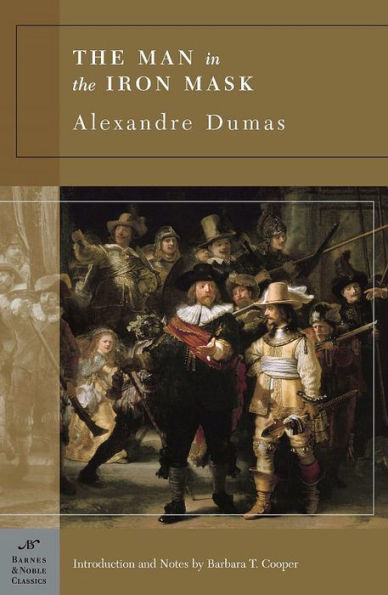Read an Excerpt
From Barbara Cooper’s Introduction to The Man in the Iron Mask
It is not at all surprising that Dumas, like Vigny, Hugo, and other writers of their day, would be drawn to the story of a masked prisoner held in isolation and accorded special consideration and respect by his jailors. As Victor H. Brombert demonstrated in his study The Romantic Prison: The French Tradition, the prison occupied a significant place in the Romantic imagination. On the one hand, it offered Romantic writers the opportunity to exploit some of the dark atmospherics and melodramatic villainy traditionally associated with the Gothic novels of Ann Radcliffe and others. On the other hand, it also provided them with a space in which to explore the inner being and the superior nature of an exceptional individual. Dumas’s early novels, from Le Chevalier d’Harmental to Georges, already included prison episodes. So did The Three Musketeers and Twenty Years After. But Dumas’s most famous fictional prisoner prior to The Man in the Iron Mask was, of course, Edmond Dantès, better known as the count of Monte Cristo—a name Dantès adopted after his escape from the Château d’If. There are some superficial similarities between Dantès and the Mask. Both men are held in solitary confinement. Both are eventually visited in prison by priests and are finally able to leave their cells as a result of that encounter, although the circumstances of their flight are totally different. Far more important than these rather facile parallels is the fact that both men are innocent victims of arbitrary decisions designed to protect another individual’s political and personal future. Those decisions lead not only to the prisoners’ unjust incarceration, but also to the erasure of their identity (Dantès’s name is replaced by a number so as to prevent others from locating him, and the Mask—whom we eventually learn is Louis XIV’s twin brother, Philippe—is given the name Marchiali and is later [in chapter 52] forced to wear an iron mask).3 Beyond that, however, the stories Dumas tells about Dantès and the Mask are more different than they are alike. Dantès uses the wealth he acquires after his escape from prison to undertake an elaborate scheme of revenge against those who wronged him. Philippe is returned to prison after a very brief period of contact with those who are responsible for his fate and is subject to even greater isolation.
The story of the fictitious masked prisoner might have been little more than another of the many interpolated episodes found in Dumas’s Musketeers trilogy (for example, Milady’s sequestration in and escape from her brother-in-law’s castle in England) were it not so clearly an illustration of the political and historical struggles that are central to Bragelonne.4 Indeed, in this final volume of the trilogy generally, and in The Man in the Iron Mask in particular, the focus is not only on the eponymous Viscount Bragelonne, son of the Comte de la Fère (known in his Musketeer days as Athos), but also on the rise to power of King Louis XIV.5 Long subject to the tutelage of his mother, Anne of Austria (widow of Louis XIII of France), and of his prime minister, Cardinal Mazarin (successor to Cardinal Richelieu), young Louis has also had to overcome the efforts of a faction of rebellious French aristocrats known as La Fronde who wished to place his uncle Gaston d’Orléans on the throne. In his minority, then, the young king not only lacked control over his political destiny but also was subject to personal humiliation. He likewise had little influence over royal finances that were managed principally by Nicolas Fouquet, the surintendant (superintendent) of finances, who was named to that post with the support of Mazarin.
Like many others in that era who either purchased their positions at court or were appointed as a result of patronage, the Surintendant ostensibly served at the pleasure of the King.6 But in fact, because he is responsible for filling the state’s coffers and for funding the personal and political expenses of the Crown, the Surintendant wielded a great deal of power over the King’s affairs. Indeed, as keeper of the King’s purse, the Surintendant will play a key role in determiningg whether or not Louis can go to war with his enemies, support his allies, assert his personal authority, and bring the nobility to heel. Fouquet’s power and wealth, and the shadow they cast over the King’s authority, are most concretely represented here by the magnificent castle and elaborate gardens the Surintendant has had constructed at Vaux-le-Vicomte (located to the south and east of Paris).7 That estate far outshines any of the King’s royal properties. (Louis would later order Versailles, not yet the elaborate palace familiar to thousands of visitors today, to be developed and decorated by some of the very same men Fouquet employed at Vaux.) Louis counts this ostentatious display of affluence and artistic patronage by a subject as yet another insult to his majesty, as Dumas clearly shows via repeated expressions of the King’s ire before, during, and after his brief stay at Vaux. It is, moreover, at Vaux that the entirely fictional attempt to replace Louis with his long-hidden, unknown twin takes place. Though unaware of that plot—indeed, he ultimately helps to foil it—Fouquet is nonetheless implicated in the undertaking because it transpires under his roof.8 The King—seconded by Jean-Baptiste Colbert, a man who is determined to undermine and then replace Fouquet— will spend much of the rest of the novel seeking to punish the Surintendant for this and other acts of lèse-majesté (offense against the dignity of the sovereign of a state), including the fortification of the island of Belle-Isle-en-Mer off the Atlantic coast of France.9





